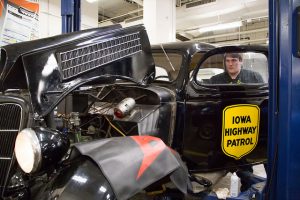Central Campus Returns to Roots in Restoring 1935 Ford
Down in the basement at Central Campus is an award-winning, nuts-and-bolts program that is the strongest remaining link to the building’s origins as an assembly plant for the Ford Motor Company.
Under the direction of Jim Nelson, who graduated in 1990 from the curriculum he now heads, the Automotive Technology department of the Career and Technical Institute trains students for careers in an industry that’s always moving ahead. Nelson’s apprentices generally are immersed in the increasingly complex ways and means of the modern horseless carriage.
But right now they’ve taken on a project that throws them into reverse, all the way back to 1935.
That was the year the Iowa Highway Patrol (later renamed the Iowa State Patrol) was established by the state legislature and an original fleet of 37 cars and 12 motorcycles took to the roads, many of them still unpaved. One of those cars, a 1935 Ford Tudor, has found its way to Nelson’s program for a mechanical overhaul. Later it will be reupholstered and eventually returned to service as a ceremonial parade and display vehicle.
Wouldn’t it be something if the car had been assembled at the Des Moines plant which, according to Nelson, included a showroom on the roof? And what if it was somehow involved in bringing Bonnie and Clyde to justice when they were marauding through these parts circa mid-30s? Alas, the story’s not that incredible. The Des Moines Ford plant specialized in the old Model-T and stopped production in 1927. As for Bonnie and Clyde, they were on the loose near Dexter in 1933.
But still…
How did the 80 year-old black-and-yellow get here?
“It’s been sitting in the basement at the State Historical Museum for I don’t know how long,” Nelson said. “We were asked to help fix it up. When it got here it wouldn’t run.” It does now, and the siren still works when you flip the toggle switch on the dashboard, but plenty of work remains.
The shop area looks bumper to bumper right now but Nelson said that’s not always the case.
“We get some work from people who didn’t want to pay what it would cost to have their cars repaired,” he said. “Here, all they pay is what the parts cost; no labor. But they have to be patient.” Sometimes people donate cars for keeps and take the tax write-off, though not as often now as formerly.
“That’s something we’d like to make people more aware of,” Nelson says. “It’s a win-win deal because it helps our students get experience and it provides a tax benefit for the donors.” Cars donated free and clear get a makeover and then go to auction with the proceeds coming back into the program.
Right now the patients in Nelson’s care include a vintage Pontiac and a Cadillac Eldorado. But you know how it is when there’s a cop in traffic. That becomes the focus of attention.
The license plate on the ’35 Ford is white with a black star and the number 40, a tribute to the first patrolman killed in the line of duty. 40 was his badge number. It’s the law enforcement equivalent of retiring an athlete’s jersey.
The speedometer on the old warhorse tops out at 100 but Nelson said he doubts the car ever could have reached that speed. Besides the road conditions back then the V8 engine produced only 85 horsepower. But if you know your TV classics it’s not much of a leap to imagine Broderick Crawford at the wheel, in pell-mell pursuit of some Clyde Barrow wannabe who’s looking in the rearview of whatever heap he’s driving and realizing he got into the wrong business.
Coming soon to a slow-rolling parade near you!





